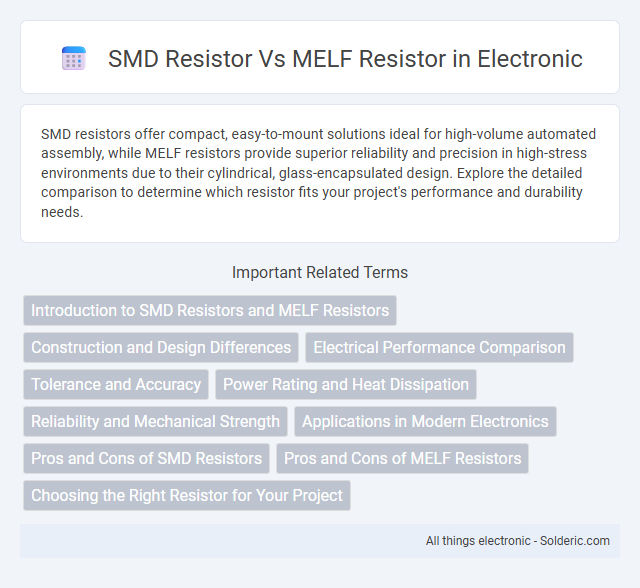SMD resistors offer compact, easy-to-mount solutions ideal for high-volume automated assembly, while MELF resistors provide superior reliability and precision in high-stress environments due to their cylindrical, glass-encapsulated design. Explore the detailed comparison to determine which resistor fits your project's performance and durability needs.
Comparison Table
| Feature | SMD Resistor | MELF Resistor |
|---|---|---|
| Package Type | Surface Mount Device (Rectangular, flat) | Cylindrical, Round, Metal Electrode |
| Size and Shape | Compact, flat design suitable for high-density PCBs | Slender cylindrical shape, requires specific pick-and-place tools |
| Power Rating | Typically 1/16 to 1/4 watt | Higher power ratings, commonly 1/4 to 1 watt |
| Precision | Standard tolerance around +-1% to +-5% | High precision with lower tolerance, typically +-0.1% to +-1% |
| Temperature Coefficient | Higher TCR, less stable with temperature variations | Low Temperature Coefficient of Resistance (TCR), better stability |
| Reliability | Good for general applications | Superior for high-reliability and precision applications |
| Placement Method | Standard SMD pick-and-place machines | Requires specialized vacuum nozzles due to cylindrical shape |
| Cost | Generally lower cost | Higher cost due to precision manufacturing |
Introduction to SMD Resistors and MELF Resistors
SMD resistors, or Surface-Mount Device resistors, are compact, rectangular components designed for direct placement on PCB surfaces, offering high precision and efficient space utilization in electronic circuits. MELF (Metal Electrode Leadless Face) resistors feature a cylindrical shape with metalized ends, providing superior reliability and better performance under high stress or temperature variations. These two resistor types serve distinct purposes, with SMD resistors favored for automated assembly and MELF resistors chosen for their durability in demanding applications.
Construction and Design Differences
SMD resistors feature a rectangular, flat ceramic body with metalized termination ends designed for surface mounting, offering compact size and ease of automated assembly. MELF resistors have a cylindrical, tubular design with metallized ends, providing superior thermal stability and precision but requiring more careful handling during placement. Your choice depends on the application's need for durability, precision, and compatibility with automated manufacturing processes.
Electrical Performance Comparison
SMD resistors typically offer stable electrical performance with good tolerance and power ratings suited for compact circuit designs, while MELF resistors excel in precision and reliability due to their cylindrical shape, providing better thermal dissipation and lower noise levels. Your choice between SMD and MELF resistors should consider factors such as power handling capacity, tolerance, and noise level requirements specific to your application. MELF resistors generally outperform SMD resistors in environments demanding higher stability and accuracy.
Tolerance and Accuracy
SMD resistors typically offer a tolerance range from +-1% to +-5%, making them suitable for general-purpose applications where moderate accuracy is acceptable. MELF resistors boast tighter tolerance levels, often as low as +-0.1%, ensuring superior accuracy and stability in precision circuits. Choosing between them depends on your application's tolerance requirements and the need for consistent resistance values under varying conditions.
Power Rating and Heat Dissipation
SMD resistors typically offer power ratings ranging from 1/16W to 1W, with efficient heat dissipation due to their flat, surface-mounted design. MELF resistors, designed in a cylindrical form, can handle higher power ratings, often up to 2W or more, and provide superior heat dissipation through their metal body and end caps. Understanding these differences helps you select the optimal component for applications requiring precise thermal management and power handling.
Reliability and Mechanical Strength
SMD resistors offer superior mechanical strength due to their flat rectangular shape, which provides better adhesion to the PCB and resistance to vibration and shock. MELF resistors, though highly reliable in terms of thermal stability and precision, have a cylindrical shape that makes them more prone to mechanical stress and soldering damage. Choosing between the two depends on your application's need for durability versus precision under harsh mechanical conditions.
Applications in Modern Electronics
SMD resistors dominate modern electronics due to their compact size and versatility in densely packed circuit boards, making them ideal for smartphones, laptops, and wearable devices. MELF resistors, known for their cylindrical shape and high reliability, excel in precision applications like aerospace and military systems where durability under harsh conditions is critical. Your choice between SMD and MELF resistors hinges on the specific requirements for size, reliability, and performance in your electronic design.
Pros and Cons of SMD Resistors
SMD resistors offer advantages such as compact size for high-density circuit designs, excellent automated assembly compatibility, and a wide range of resistance values with tight tolerances. Their cons include lower power dissipation compared to MELF resistors and potential reliability concerns under extreme environmental conditions due to mechanical stress. You benefit from using SMD resistors in applications demanding miniaturization and high-volume manufacturing, while MELF resistors excel in high-reliability and high-temperature scenarios.
Pros and Cons of MELF Resistors
MELF resistors offer superior reliability and precision due to their cylindrical glass body, which provides excellent thermal stability and resistance to environmental stress. However, their round shape complicates automated placement processes compared to flat SMD resistors, increasing manufacturing costs and assembly time. MELF resistors are ideal for high-performance applications but less suited for mass production environments where speed and cost efficiency are critical.
Choosing the Right Resistor for Your Project
Choosing between an SMD resistor and a MELF resistor depends on your project's specific requirements for size, tolerance, and reliability. SMD resistors offer compact size and ease of automated assembly, making them ideal for high-volume production and space-constrained designs, while MELF resistors provide superior thermal stability and precision, suitable for high-reliability applications. Your decision should balance factors such as power dissipation, noise performance, and mounting compatibility to ensure optimal circuit functionality.
SMD resistor vs MELF resistor Infographic

 solderic.com
solderic.com